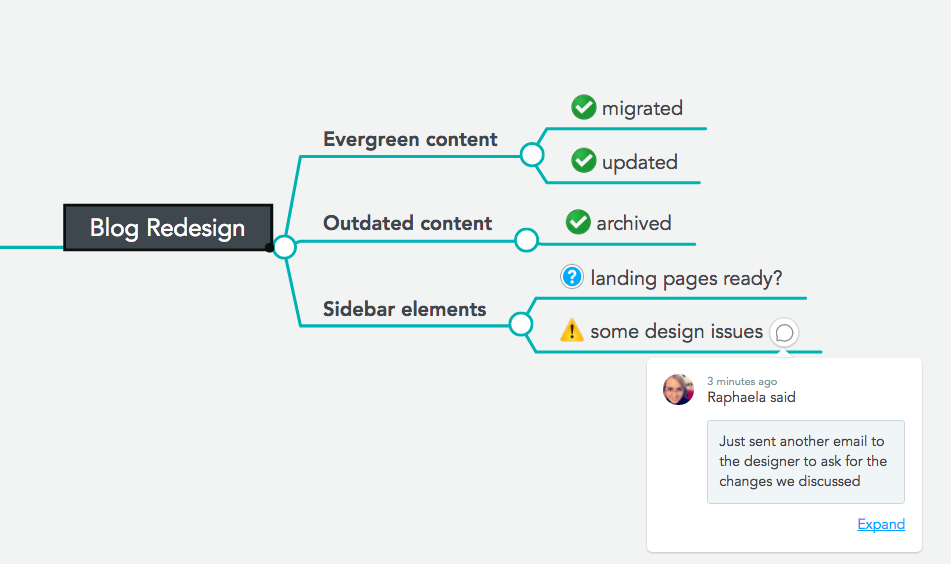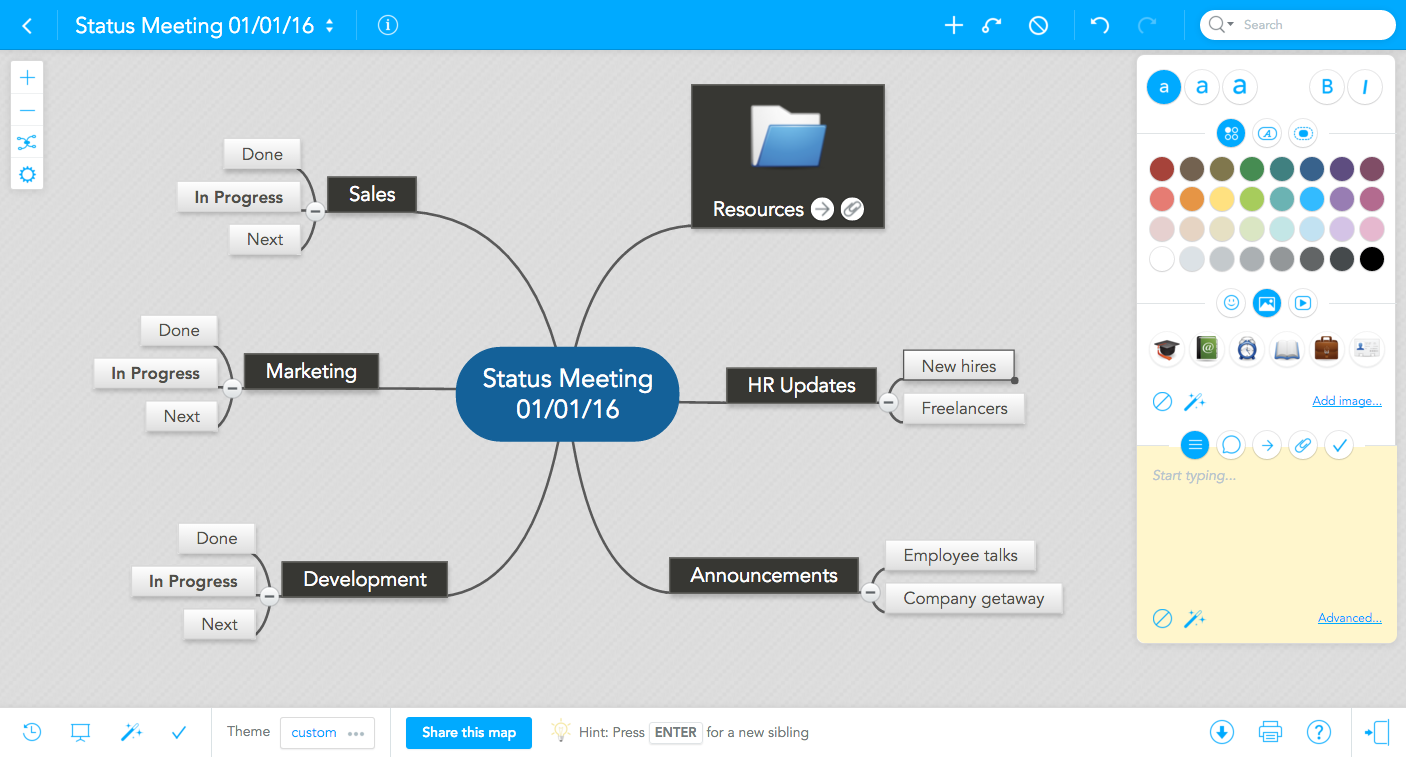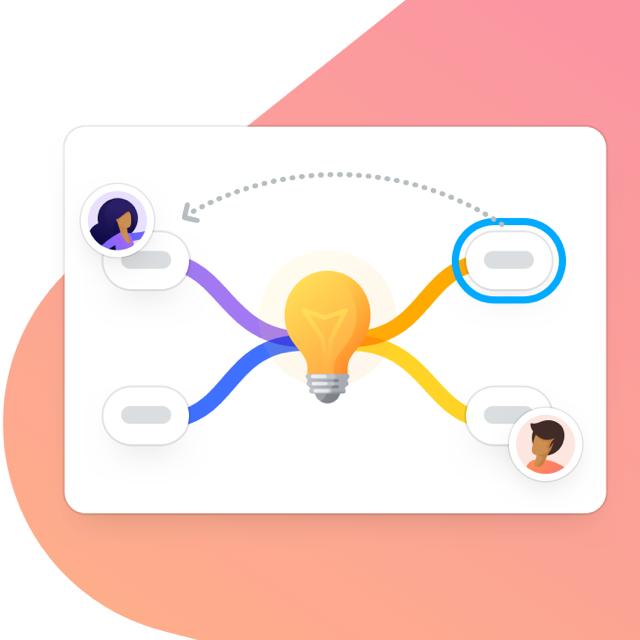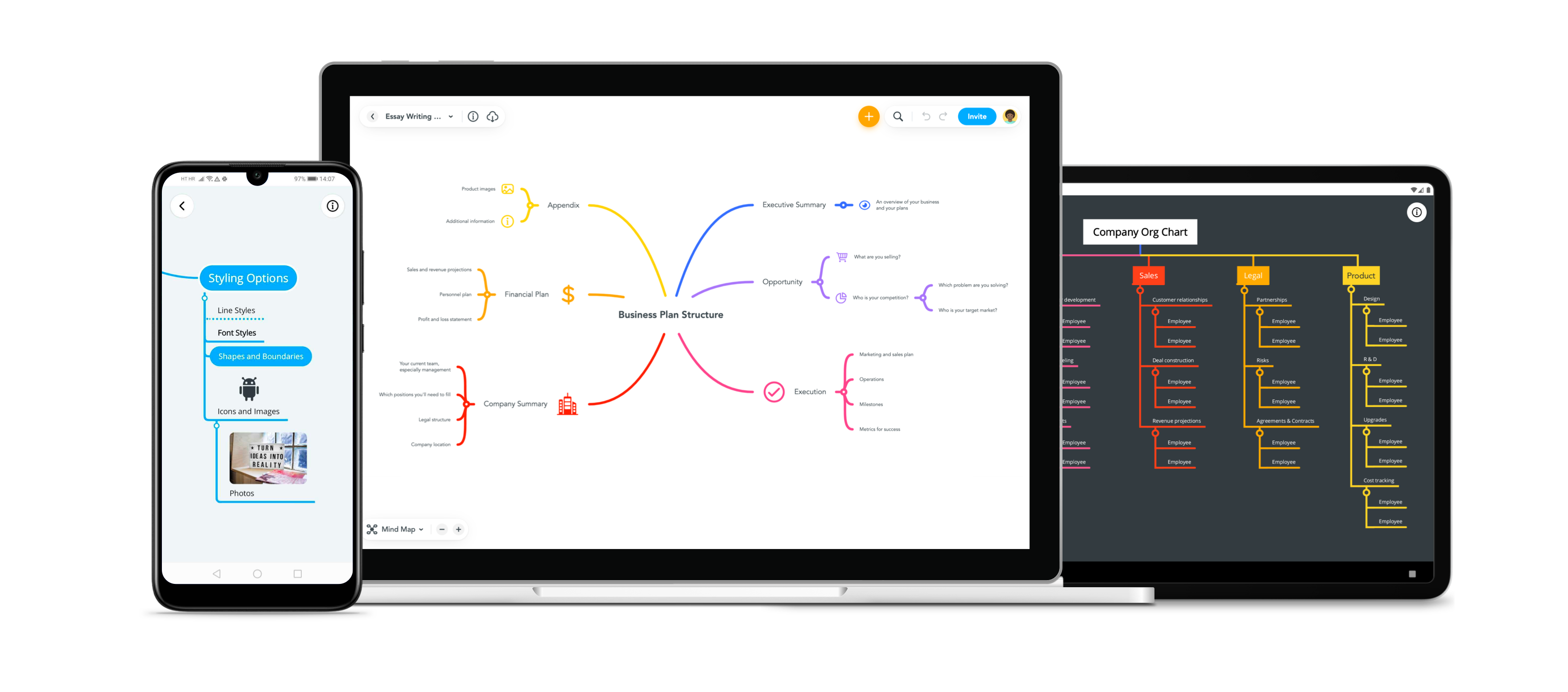Meetings take up a huge chunk of work time, and too often the results of those hours of discussions and brainstormings have no actionable outcome. In this article, we’ll introduce you to a system that ensures more effective meetings, using our online mind mapping tool MindMeister.

This is where MindMeister can help:
- Prepare and distribute an effective meeting agenda in a mind map
- Add all relevant links, graphics and files to the map
- Create engaging presentations from mind maps with a few clicks
- Take efficient meeting minutes that can be shared with participants
- Create and assign actionable tasks right inside the map
Mind maps are a very effective tool when it comes to organizing meetings. They offer a clear structure and a great overview of the agenda.
Why Use Mind Maps for Meeting Management?
Mind maps are visual representations of information. Instead of the linear text format you know from Word documents, mind maps organize your agenda and meeting minutes in a two-dimensional structure that’s easy to understand and lets you see all important notes at glance. Meeting mind maps visualize connections between ideas, highlight priorities, and hold a complete record of your discussion on one single page.
With MindMeister being completely web-based, all meeting participants can also contribute to the map simultaneously. They can add notes to topics, vote on ideas, attach visual media, create tasks and assign priorities.
We could also use Google Documents for our meeting minutes, but using mind maps is more visually attractive and easier to understand, as agendas, decisions, opinions, everything is connected in one map.
Using Mind Maps for Running Effective Meetings
1. Preparing the meeting agenda
With their visual structure, mind maps enable participants to get an instant overview of the entire meeting agenda and dive right into the discussion. When preparing a meeting mind map, you can start with a blank map or use one of MindMeister’s meeting templates, which are all available in the template library.
The topic of your meeting always goes into the center of the map, but the rest of the map’s structure depends on the type of meeting you’re conducting. Here’s an example of a simple but effective meeting mind map based on one of our map templates:
As you can see, this map records who is attending the meeting. It offers space for all meeting-relevant documents and has branches for important announcements, discussion notes and action items resulting from the discussion. This can be a useful structure for meetings that are a little more formal and require an exact record that you can refer to later on.
![]() Tip: Create a system of color codes and icons to highlight individual elements and quickly signal information to people. Once you’ve developed a system that works well for your needs you can re-use it for all your future meeting maps.
Tip: Create a system of color codes and icons to highlight individual elements and quickly signal information to people. Once you’ve developed a system that works well for your needs you can re-use it for all your future meeting maps.
Here’s an example of a status meeting map similar to the one we use at MindMeister to conduct our weekly status meetings. The Next – In Progress – Done structure in the map reflects the Kanban system we use in our MeisterTask project boards.
To save time we don’t create a new mind map from scratch every week. Instead, we simply duplicate the map we used the previous week and share the clone with the department heads a day before the meeting. This way, they can simply drag and drop items that were previously in ‘Next’ to ‘In Progress’ and move completed items from ‘In Progress’ to ‘Done’.
![]() Tip: Using the sidebar in the mind map editor you can add links to external websites, Google Docs or other mind maps. You can also attach related files such as project plans or reports and upload graphics, diagrams, videos, and more.
Tip: Using the sidebar in the mind map editor you can add links to external websites, Google Docs or other mind maps. You can also attach related files such as project plans or reports and upload graphics, diagrams, videos, and more.
2. Creating Engaging Presentations for Your Next Meeting
Whether you’re presenting an idea to your team or pitching to busy executives, a mind map is a great format that will engage your audience and help them follow your thought process. Creating mind map presentations is also simple and quick — a dynamic slideshow can be put together in less than three minutes! Check out this video to see it done in real-time:
The best part about a mind map presentation is that you — and anybody else who’s invited to the map — can make notes and comment on ideas directly in the map, be it during your presentation or during the discussion that follows it.
![]() Tip: For in-person meetings, you can simply connect your device to a projector and have the presentation projected onto a screen while you do your pitch. If your audience is not in the same room with you, you can invite them to the mind map beforehand and use MindMeister to broadcast the presentation to them in real-time.
Tip: For in-person meetings, you can simply connect your device to a projector and have the presentation projected onto a screen while you do your pitch. If your audience is not in the same room with you, you can invite them to the mind map beforehand and use MindMeister to broadcast the presentation to them in real-time.
Thanks to MindMeister, our meeting times have reduced drastically. Meetings are short and sharp, because we have all important information prepped before we go in.
3. Taking Efficient Meeting Minutes
Even if you haven’t prepared the meeting agenda up front you can always quickly open a blank map and start taking notes during meetings. Mind maps are a fantastic format for any type of note-taking. Here are a few reasons why:
- Instead of mindlessly transcribing what you hear word for word, mind maps encourage you to take fewer yet more meaningful notes.
- You can easily add information anywhere on the map, which is especially useful if the discussion jumps back and forth between a number of topics.
- You can use key shortcuts to add new topics and thus take notes with incredible speed. This is particularly important during creative brainstorming sessions where a lot of valuable ideas are generated in very little time.
- You can create topics for important keywords and add more detailed information in the notes section of each topic. This will help keep your map clean and ensure it doesn’t get too cluttered or large.
When it comes to generating ideas and working through creative tasks, mind maps are 30% more efficient than linear documents.
4. Creating and Assigning Tasks
We really can not stress this enough: An effective meeting never ends before clear, actionable tasks have been defined and assigned to the persons responsible. If you leave the room before writing down exactly what needs to be done, you risk that your best ideas never get implemented.
With MindMeister, you can create tasks right inside the mind map you used for note-taking. The mind map editor offers essential task management capabilities like setting due dates, assigning tasks to map collaborators, marking completion and more. Simply select a topic in your map and use the widget in the sidebar to turn the topic into a task.
![]() Tip: MindMeister seamlessly integrates with the online task management tool MeisterTask. You can log in to MeisterTask with your existing MindMeister account and export tasks from your map directly into agile project boards. Take a look at the short video below to see this workflow in action:
Tip: MindMeister seamlessly integrates with the online task management tool MeisterTask. You can log in to MeisterTask with your existing MindMeister account and export tasks from your map directly into agile project boards. Take a look at the short video below to see this workflow in action:
So this is how mind maps can help you run effective meetings and ensure all meeting participants are always on the same page. If you give this workflow a try, let us know how you get on in the comments below!
Manage Meetings with Online Mind Maps
Get started!








